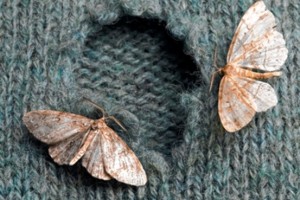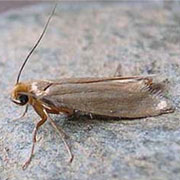 Have you ever taken a sweater out of your closet, only to find it destroyed with holes? Who are the culprits? Moths. Of course, you want to deal with the problem before it gets out of control. But it is important to understand the root of the issue before learning how to deal with it.
Have you ever taken a sweater out of your closet, only to find it destroyed with holes? Who are the culprits? Moths. Of course, you want to deal with the problem before it gets out of control. But it is important to understand the root of the issue before learning how to deal with it.
Contrary to popular belief, the adult moths are NOT the clothe-eating culprits. It is actually their larvae, which are in caterpillar form. The adult moths do not even have the capability to eat clothing, even if they wanted to, since only the larvae have the mouthparts capable of chewing.
So why do adult moths choose your closet out of anywhere else to lay their eggs?
The answer is two-fold. First off, clothing moths are attracted to darkness, and closets provide that lack of light they seek. Second, the larvae have a very specific diet with their main source of food being the protein, keratin, which is found in animal fibers. Therefore, many of the clothes we wear, including furs, leathers, wool, silk, and cashmere that come from animals contain keratin in their fibers.
Do all species of moths invade your closet?
No. Actually, only two species of moths in the U.S. are known to damage clothes – the Webbing Clothes Moth and the Casemaking Clothes Moth.
The Webbing Clothes Moth is the most commonly encountered clothes moth throughout the United States. The body and wings of the adult are uniformly buff colored and its head has light reddish hairs on top. Adult Webbing Clothes Moths may be found at any time of the year, but are more abundant during the warm summer months. Webbing Clothes Moth larvae spin little tunnels that they travel through as they devour your sweaters and coats. These feeding tunnels are often the same color as the material of the clothes the moth larvae is damaging, as the tunnels are made of fabric particles, making it very difficult to see.
 Casemaking Clothes Moths, on the other hand, are not nearly as common as the Webbing Clothes Moths. This species is more frequently encountered in the southern United States and is more brown in color with 3 dark spots on the wings to identify it. Casemaking Clothes Moth larvae have portable cases that they carry along with them as they feed. These cases grow along with the larvae, and they also take on the color of the fabric the larvae are feeding on, making them almost impossible to spot, just like the tunnels of the Webbing Clothes Moth larvae.
Casemaking Clothes Moths, on the other hand, are not nearly as common as the Webbing Clothes Moths. This species is more frequently encountered in the southern United States and is more brown in color with 3 dark spots on the wings to identify it. Casemaking Clothes Moth larvae have portable cases that they carry along with them as they feed. These cases grow along with the larvae, and they also take on the color of the fabric the larvae are feeding on, making them almost impossible to spot, just like the tunnels of the Webbing Clothes Moth larvae.
How do you protect your closet?
- Cleaning: The best way to deal with a moth infestation is to dry clean anything made of animal fibers and wash everything else in the washing machine on the hot cycle. Then, to catch any other eggs or larvae, vacuum the floors and shelves thoroughly. You can also place infested clothes in plastic bags and putting them in the freezer for 7 to 10 days to kill eggs and larvae.
- Storage: When you pack up winter clothes for the summer months, make sure they are cleaned and stored in airtight containers. That way, nothing can get in and nothing can get out.
There you have it! You now know why moth larvae eat your clothes and how to protect your closet from them. But keep in mind that moth larvae are not the only pests that enjoy munching on your clothes. Other types of insects and beetles do too, so be certain to contact a pest control professional to protect your home and your closet.
